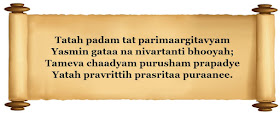Verse 14
Having become the fire Vaiśhvānara, I abide in the body of living beings and,
associated with the Prana and Apana, digest the fourfold food.
Sri Krishna says that God
exists inside all living beings as Vaiśhvānara, meaning “fire of
digestion,” which is ignited by the power of God. The Bṛihadāraṇyaka Upaniṣhad has also
stated:
ayam agnir vaiśhvānaro yo ’yam
antaḥ puruṣhe yenedam annaṁ achyate (5.9.1)
“God is the fire inside the
stomach that enables living beings to digest food.”
It is a wonder that we are able to eat such a
large variety of food, and yet derive enough energy to keep our bodies running
throughout our lives, all due to the functioning of the Vaiśhvānara fire.
It is supported by two vayus or
forces known as the Praana and the Apaana vayus.
The Praana vayu brings food towards
the digestive organs. Vaiśhvānara is the process of digestion and
metabolism.
The Apaana vayu pushes non-essential
portions of the food out into the world.
When the prana and
the apana conjointly act at the root of the naval within the
stomach, they operate in a different manner altogether, and go by the name
of samana; and that creates a kind of heat in the stomach, which is
necessary for the digestion of food.
This heat is known as Vaiśhvānara-agni, the Universal Fire. It is the
energy of God that operates through the metabolic process of individuals and
causes the digestion of the four kinds of food—pachamyannam chaturvidham.
Chaturvidham means
four types and annam means food. Food is
categorized into four types:
1. Bhojya -
Foods that are chewed, such as bread, chapatti, etc.
2. Peya -
These are mostly liquid or semi-solid foods which we have to swallow or drink,
such as milk, juice, etc.
3. Kośhya -
Foods that are sucked, such as sugarcane.
4. Lehya -
This includes foods that are licked, such as honey, etc.
The expressions that He becomes the light of the
sun, moon and fire etc. are meant to indicate the predicated relationship that
these objects have in regard to Him.
According to Ayurvedic sastra, we understand that there is a
fire in the stomach which digests all food sent there. When the fire is not
blazing, there is no hunger, and when the fire is in order, we become
hungry.
Sometimes when the fire is not
going nicely, treatment is required. In any case, this fire is representative
of the Supreme Personality of Godhead.
Vedic mantras also confirm that
the Supreme Lord or Brahman is situated in the form of fire within the stomach
and is digesting all kinds of foodstuff. Therefore since He is helping the
digestion of all kinds of foodstuff, the living entity is not independent in
the eating process.
Unless the Supreme Lord helps
him in digesting, there is no possibility of eating. He thus produces and
digests foodstuff, and, by His grace, we are enjoying life.
In the 10th chapter Krishna has referred to the vibhūtis of the Supreme. He has
explained how the Supreme, otherwise imperceptible and omnipresent,
remains incomprehensible, though manifest in the whole creation.
“What need is there for all this detailed knowledge, O Arjuna? Simply
know that by one fraction of my being, I pervade and support this entire
creation.”
(Chapter 10, verse 42)
In order to facilitate a full comprehension of
the Supreme, Krishna lists a variety of objects and qualities.
The
references include letters, words, mountains, war-weapons, fame, patience,
will, memory, spirituality and the rest. Finally
he declares that all put together, the entire visible glory around us is merely
one small fraction of the Supreme.
So we see that
production, distribution and ultimate consumption of energy that happens in us,
and happens in any other living being, is nothing but Easvara / Supreme Consciousness.
Remembering
the above essence is a great way to reduce our ego and see our oneness with the
world.
Love.























